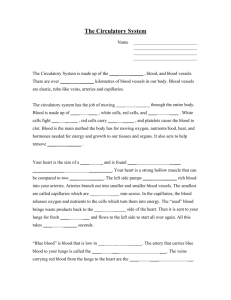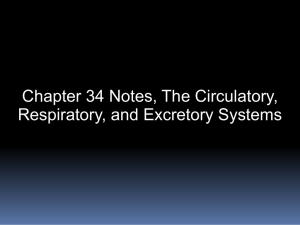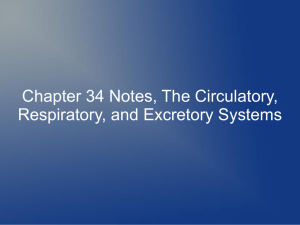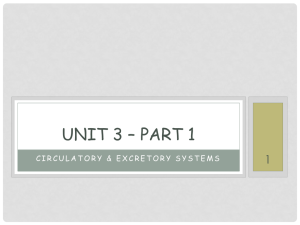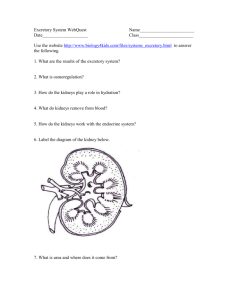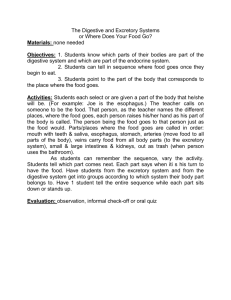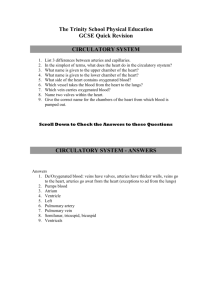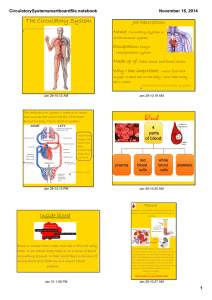excretory system
advertisement
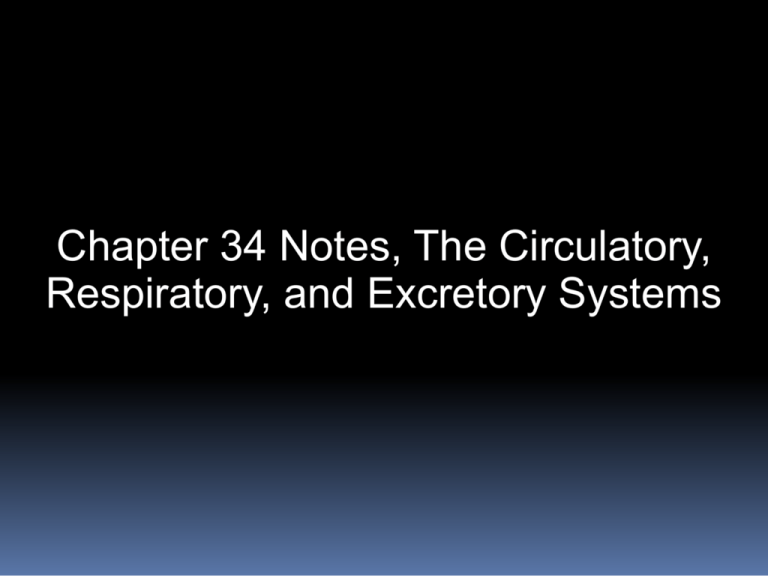
Chapter 34 Notes, The Circulatory, Respiratory, and Excretory Systems The Circulatory System the circulatory system is the body's transportation system. The circulatory system consists of the blood, the heart, the blood vessels, and the lymphatic system. The circulatory system transports oxygen, nutrients, disease-fighting materials, cell fragments and proteins used for blood clotting, and the circulatory system distributes heat uniformly throughout the body. The Circulatory System Blood Vessels Just like a highway transportation system has roads, on and off ramps, stop lights etc., the circulatory system has a complicated network of blood vessels that perform different functions. Oxygen-rich blood is carried away from the heart in blood vessels called arteries. Arteries are strong thick-walled vessels that are elastic and durable. They are able to withstand high pressures exerted by the pumping heart. Arteries Blood Vessels When arteries get closer to their intended destination (usually an organ or a tissue), they begin branching off into thin-walled delicate vessels known as capillaries. Capillaries are small, delicate blood vessels, that sometimes are only 1 cell thick, where the exchange of important substances and wastes occur. After the blood travels through the capillaries they enter the veins, which carry oxygen-poor blood back to the heart. Capillaries and Veins Blood Vessels Veins do not have to withstand high pressures as the arteries do. Once the blood has passed through the capillaries, much of the blood pressure generated by the heart has already been reduced. Veins rely on the movement of skeletal muscles to pump the deoxygenated blood back to the heart. Veins also have one-way valves that prevent blood from flowing backwards. Arteries and Veins The Heart The main function of the heart is to pump oxygenated blood to the body, and to pump deoxygenated blood to the lungs. The heart is divided into four chambers. The two chambers on the top of the heart are the right atrium and left atrium (plural, atria). The right atrium receives deoxygenated blood from the body. The left atrium receives oxygenated blood from the lungs. Four-Chambered Heart The Heart The two lower chambers of the heart, that pump blood away from the heart are called the right and left ventricles. The strong thick-walled left ventricle pumps oxygenated blood to the body. The thinner- walled right ventricle pumps deoxygenated blood to the lungs. The beating of the heart is controlled by a group of cells in the right atrium called the pacemaker or sinoatrial node (SA node for short). The SA node causes the atria to contract, the Atrioventricular (AV) node contracts the ventricles. The Human Heart The Blood Blood is made up of four components; plasma, red blood cells, white blood cells, and platelets. Plasma is a clear, yellowish fluid. More than 50% of the blood is plasma. Plasma is about 90% water and 10% dissolved materials. Plasma carries digested food, vitamins, minerals, hormones, and waste products. Red blood cells carry oxygen to all the body's cells. Red blood cells look like donuts. Composition of Blood The Blood Red blood cells in mammals have no nuclei. This is an adaptation that allows the blood cells to carry more oxygen. Red blood cells are made up of an iron-rich protein known as hemoglobin. Iron turns red in the presence of oxygen, giving blood rich in oxygen its reddish color. White blood cells are cells that fight off diseases. Red and White Blood Cells The Blood Platelets are cell fragments that form blood clots when a cut occurs. When a blood vessel is cut, platelets collect and stick to the site of the wound. The platelets then release chemicals that produce a protein called fibrin. Fibrin weaves a network of fibers across the cut that traps more platelets and red blood cells. As more platelets and red blood cells collect, eventually a blood clot forms. The Blood Circulatory System Disorders Blood clots and deposits of fats can sometimes lead to a blockage of arteries. A disorder caused by the condition of blocked arteries is referred to as atherosclerosis. Signs of clogged arteries are high blood pressure and high cholesterol. Atherosclerosis can lead to diseases like heart attacks or strokes. Circulatory System Disorders Heart attacks occur when blood is prevented from returning to the heart. Strokes occur when blood is prevented from reaching the brain. Heart attacks result in damage to the heart or death. Strokes most often result in brain damage. Respiration In order to function, all of the body's cells need a continuous supply of oxygen, and they need to expel carbon dioxide produced from respiration. The mechanical action that moves air into and out of the lungs is called breathing. External respiration is the exchange of gases that occurs between the air and the blood. Internal respiration is the exchange of gases between the blood and the body's cells. Breathing and Respiration The Respiratory System The tissues and organs of the respiratory system include the nasal passages, pharynx, larynx, epiglottis, trachea, lungs, bronchi, bronchioles, alveoli, and the diaphragm. When air first enters the mouth or the nose, small hairs in the nose and nasal passages filter out dust and particles. The filtered air then passes through the area of the upper throat called the pharynx. Nasal Passages and Pharynx The Respiratory System A small flap of tissue called the epiglottis covers the larynx (voice box). The epiglottis prevents food from entering the trachea (windpipe). After air passes through the larynx, it travels down the trachea. The trachea branches into two large tubes called the bronchi. After the air passes through the bronchi it enters into the lungs. Once into the lungs, the bronchi branch off into smaller tubes called bronchioles. The Respiratory System At the end of the bronchioles are small air sacs that are only one cell thick and surrounded by capillaries. These air sacs are called alveoli. Gas exchange takes place in the alveoli. The lungs fill up with air when the muscular diaphragm contracts. When the diaphragm muscles relax, the lungs push air back out. There are many common disorders of the respiratory system like asthma, bronchitis, emphysema, pneumonia, and lung cancer. The Respiratory System The Excretory System The main function of the excretory system is to remove the body's wastes. Another important function of the excretory system is it helps regulate the body's fluids, salt concentrations, and the pH of the blood. The main organs of the excretory system include the skin, lungs, liver, and kidneys. The lungs excrete carbon dioxide, and the skin excretes water and salt, but the kidneys are the most important part of the excretory system. The Human Excretory System The Excretory System Small bean-shaped organs called kidneys do the biggest job of the excretory system. The kidneys are divided into three parts; the renal cortex, renal medulla, and renal pelvis. Inside the kidneys there are approximately 1 million filtering units called nephrons. In the nephrons, blood enters a structure called the Bowman's capsule. Inside the Bowman's capsule is a ball of capillaries called the glomerulus. The Excretory System The Excretory System When the blood reaches the glomerulus and the Bowman's capsule, high pressures filter urea out of the blood. Larger molecules like blood cells mostly stay in the bloodstream. The filtrate coming out of the Bowman's capsule enters an area of the nephron called the convoluted tubule and the loop of Henle. This part of the nephron reabsorbs any of the good substances like glucose and minerals. Anatomy of the Kidneys The Excretory System Eventually at the end of the nephron, the waste product that will be removed is called urine. Urine leaves the nephron through collecting tubules. The collecting tubules lead to ureters. The ureters lead to the urinary bladder, where urine is stored until it is finally removed from the body. Remarkably, even though kidneys filter about 180 L (about 48 gallons) of blood each day, they only produce about 1.5 L (almost ½ gallon) of urine each day. The Kidneys and Nephron Filtration
